All about bastard files
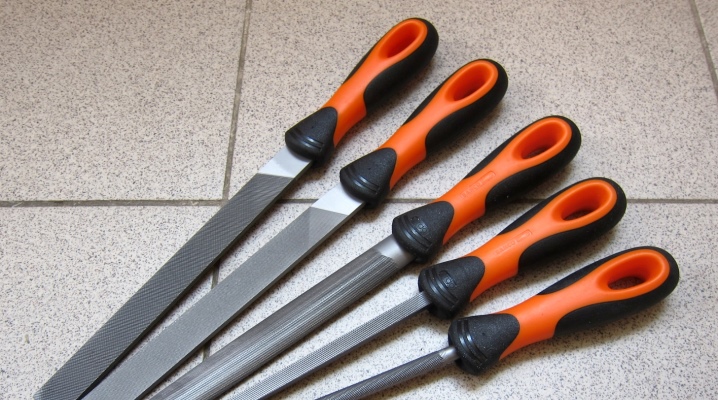
In almost every home there is a set of simple locksmith tools of essentials, where, along with a hammer, an adjustable wrench, pliers and a screwdriver, a file is always present. There are quite a few options for this simple device, of which the most common is a fighter file.

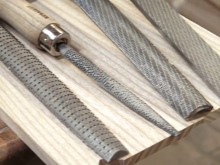

What it is?
A fist file is a general-purpose locksmith's tool used for rough processing of hard surfaces. The main difference between a fighting tool and other types is the presence of a large notch: there are at least 5 and no more than 12 large teeth per 1 square centimeter, capable of removing up to 0.1 mm of material in one pass. The dotted notch of bastard models is distinguished by clearly formed rows, and the rows can be either straight or slightly curved. The working depth of the material is controlled by the pressing force, the number of strokes and the speed of the file.
The main task of such a file is to quickly and deeply remove the upper words of the processed surfaces, as well as to give the workpieces the desired shape. The file is used both for processing straight and curved planes, and for working with holes. These tools clean various parts from rusty deposits and old dirt, modify products to their final dimensions, grind places of impacts and dents, remove burrs, clean welded seams and oxidized contacts, sharpen saw and hacksaw teeth.

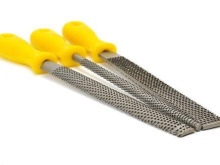

The advantages of bracing models include ease of use, low cost and no need to acquire special skills. Unlike a power tool, the file does not require a nearby outlet, which allows it to be used in the field. In addition, there are no dangerous rotating elements in its design, and during operation there are no flying sparks and chips.
A plus is the fact that, unlike a power tool, a file removes only a small layer of material, which means that it is almost impossible for them to spoil the part being ground. The disadvantages of bastard files include the impossibility of finishing workpieces and the need for physical effort.

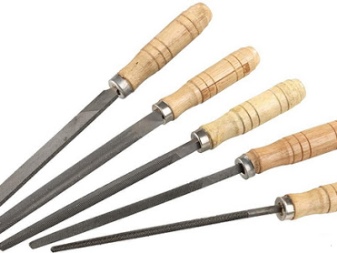
Species overview
The classification of firing files is made by number, size, shape and purpose.
- There are two file numbers for fighting files - zero and first. Null samples are capable of removing from 7 to 15 mm of metal, while model # 1 - only 3-7 mm.
- By their size, files can be short or long (up to 400 mm), therefore, the choice of the desired instance depends directly on the area of the part. The best option would be a tool that is 15 cm longer than the length of the workpiece.
- As for the working forms, the files in their section are flat, round, semicircular, square, rhombic and triangular. The handle is usually round, made of hardwood or plastic, and fits comfortably in the hand. Some models do not have a handle. Their working surface is often divided into two parts, differing from each other in roughness (one half is represented by a notch number 1, the other - 0)
- According to their purpose, bastard files are divided into models for wood and metal. For the manufacture of the former, various metal alloys are used, while the latter are made only of tool alloy steel.


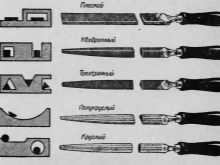
Selection Tips
The choice of a broom file should be based on the specifics of the work that is going to be performed. Below are the main criteria for selecting a tool, taking into account the characteristics of a particular type.
- First of all, it is worth paying attention to the metal being processed. If it is a brass, aluminum or copper workpiece, then it is better to take a file with a single cut. It is undesirable to use smaller ones, for example, velvet models, since soft chips instantly clog the spaces between the rows of notches, and the work becomes ineffective. But rough file # 1 for rough turning of soft metals will be just right. A velvet file or file is a good choice for finishing such surfaces.
- Choosing between the zero and the first number of a draughty instrument, one should focus on which layer of material to remove: if large, then take "zero", if a little less - "one".
- When choosing the shape of the file, the configuration of the workpiece to be processed should be taken into account.... For straight surfaces, a flat model is suitable, for curved surfaces - round and semicircular. It is convenient to cut corners up to 60 degrees with semicircular and triangular tools, and a square section is suitable for working with narrow workpieces. If you need to file the teeth of an asterisk or gear, then it is better to use a rhombic model.


Features of operation
The file is very easy to use. In order to start work, the workpiece is securely fixed in a vise, cotton gloves are put on and the handle of the tool is wrapped so that its end rests on the palm. The free hand is placed on top of the other end of the file and begins to move back and forth. The peculiarity of the bristle notch is the inclination of the teeth in one direction, therefore, grinding the top layer of metal or any other material is possible only when the file moves forward. Accordingly, it is only necessary to press on it when moving forward.
It makes no sense to apply force when moving the tool in the opposite direction.



When working with fighter models, do not forget about safety precautions.
- In the process of working with a file, you must rely on both legs. The position should be stable, and the clothing should not hinder movement. An uncomfortable position of the body will lead to the tool slipping during operation and serious injury to the fingers.
- During processing, you need to ensure that keep your fingers away from the cutting surface of the tool.
- When moving the file forward, do not allow so that it hits any obstacle.
- It is forbidden to brush off shavings from a file or workpiece with bare hands or blow them off. At the end of the work, the garbage is collected with a special brush and disposed of.
- Use a tool with visible defects on the working surface forbidden.


Care rules
In order for the instrument to serve as long as possible, it should be properly and promptly looked after. Below are the basic rules for storing and caring for a file, following which you can significantly increase the service life of the tool.
- The place for storing the file must be chosen in such a way that so that moisture does not get on itwhich leads to corrosion, as well as oils and grease-containing substances that negatively affect the sharpness of the notch.
- So that the teeth of the notch are not clogged with metal dust and shavings, it is recommended to rub the tool with chalk.
- It is undesirable to use a file for descaling, as this leads to chipping of the teeth of the notch and reduces the life of the tool.
- It is not allowed to hit with a file on hard objects, and also throw it on the concrete floor and metal surfaces. Experts recommend installing a wooden stand and placing the instrument on it.


At the end of the work, the file is well cleaned with a stiff brush, washed in gasoline and allowed to dry.
All about broom files, see the video below.













The comment was sent successfully.